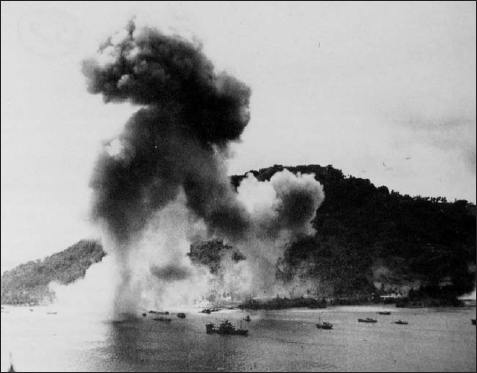
In the early morning hours of 12 February six four-engine H8K “Emily” flying boats raided Roi, bombing the huge Marine and Navy ammunition, fuel, and supply dump in the island’s center. Some 85 per cent of the supplies and 35 per cent of the equipment were destroyed, 30 men killed, and 300 wounded, mostly Seabees. The raid had staged through Ponape from Saipan 1,300 miles (2,092km) to the northwest.
Despite the occupation of Kwajalein, Majuro, and Eniwetok Atolls, Operation “Flintlock” was not yet over. The 22nd Marines, operating from Kwajalein, conducted Operation “Flintlock, Jr.” between 7 March and 5 April 1944. Its goal was to destroy any Japanese elements, installations, and materiel in the Lesser Marshalls and inform natives the US was in control while establishing good relations with them. The 22nd Marines secured 14 mostly unoccupied atolls and islands. Usually one or two rifle companies landed by amtrac were employed with civil affairs (military government) and medical personnel to assist the natives. Twenty-nine landings were conducted on these islands, resulting in almost 100 Japanese killed and a few captured. Only two Marines were killed. The Japanese were lookouts, weather parties, and stranded airmen or sailors. A detachment of the 1st Defense Battalion secured unoccupied Erikub and Aur Atolls on 17 April, and I/3/111 Infantry seized Ujelang Atoll on 21 April killing 18 Japanese.

Carrier air strikes hit Dublon Island in Truk Atoll, Japan’s “Gibraltar of the Pacific,” on 17–18 February during Operation “Hailstone”. This island housed the main IJN base in the atoll.
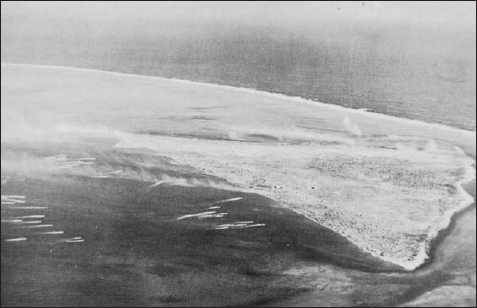
The W-shaped formation of amtracs and amphibian tanks approach Engebi Island, Eniwetok Atoll, from the south. The 4,025ft (1,227m) airfield parallels the island’s northwest shore. The denser vegetation of the large palm grove can be seen on the right portion of the island.
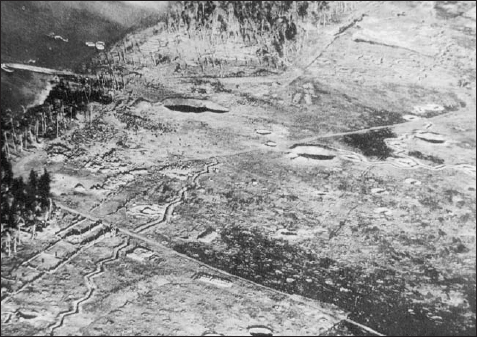
The south shore of Engebi Island is covered with hundreds of bomb and shell craters as well as an extensive trench system. The photo was taken three weeks before the assault; by the time of the attack itself the island had taken an even heavier pounding. The small pier to the left separates Beaches Blue 3 and White 1.
The Japanese still held out on Mille, Maloelap, Jaluit, and Wotje Atolls and Kusaie, Wake, and Nauru Islands. Rear Admiral Masuda Nisuka commanded the 13,000 personnel from Jaluit. Beginning on 4 March, the 4th Marine Base Defense Aircraft Wing, headquartered on Majuro, and Seventh Air Force commenced a concerted campaign to neutralize the Japanese garrisons, which continued until the war’s end. Navy Aviation and Army Air Forces had previously destroyed most Japanese aircraft on these islands. The 13,000 tons of aerial-delivered ordnance, coupled with frequent naval shelling, killed 2,564 Japanese and 4,876 died of disease and starvation; the Marines sprayed oil over the garrisons’ gardens. Fighter-bomber units deploying to the Pacific would first serve in this role perfecting their bombing techniques before moving forward to support other operations as new units replaced them. The Japanese survivors would surrender on 2 September 1945.
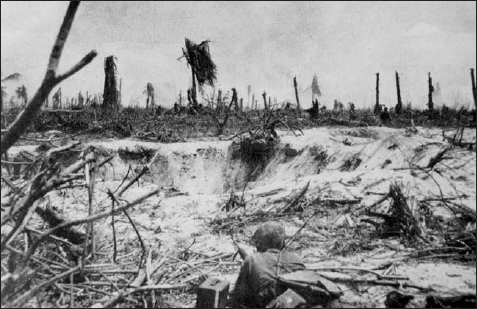
A marine on Engebi surveys a 500lb bomb crater before advancing. Both the Marines and Japanese habitually used such craters for shelter and cover.
Seabee battalions would construct numerous airfields in the Marshalls to support that summer’s Marianas operation. Besides an airfield for Marine operations and Army Air Forces staging efforts, another was built for the Navy carrier replacement aircraft pool, as well as a seaplane base on Majuro, the latter also serving as a fleet anchorage with fleet service facilities and a submarine base.
In Kwajalein Atoll airfields were built on Roi and Kwajalein Islands and a seaplane base on Ebeye. In Eniwetok Atoll airfields were built on Eniwetok and Engebi Islands and a seaplane base on Parry. The atoll was used as a major fleet anchorage, though no shore facilities were developed other than a recreation center. Eniwetok served as the staging base for the Marianas expedition. Besides supporting operations in the Marianas all of these airfields supported the neutralization of the islands still in Japanese hands.
| Operation | KIA | DOW | WIA | MIA | Total |
| Roi-Namur | 175 | 31 | 617 | 181 | 1,018 |
| Kwajalein/Engebi | 142 | –7 | 845 | 2 | 989 |
| Eniwetok (USMC) | 181 | 38 | 568 | 39 | 826 |
| Eniwetok (US Army) | 94 | –7 | 311 | 38 | 443 |
| Island | KIA | POW |
| Roi-Namur adjacent islands | 70 | 3 |
| Roi-Namur | 3,500 | 87 |
| Kwajalein adjacent islands | 185 | 33 |
| Kwajalein | 4,300 | 166 |
| Kwajalein northern islands | 400 | 2 |
| Ebeye | 450 | 7 |
| Engebi | 1,280 | 16 |
| Eniwetok Island | 800 | 23 |
| Parry | 1,300 | 66 |
| Lesser Marshalls | 116 | 16 |
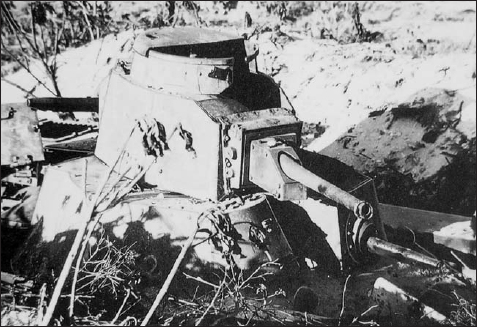
A dug-in Type 95 (1935) light tank on Engebi. Three of these tanks, armed with a 37mm gun and two 7.7mm machine-guns, were dug in on each of Eniwetok Atoll’s three defended islands. Only on Parry did they attempt a counterattack. Shermans easily knocked out the dug-in tanks.
Operation “Flintlock” was particularly important because it illustrated that the many hard lessons learned at Tarawa had been successfully implemented. While there were instances of confusion and misunderstood orders, overall the multiple landing operations went very well and in many ways set the standard for future operations. This was also the first large-scale employment of amtracs to deliver assault waves. While problems were encountered, mainly because of too few amtracs being available, their employment in such a manner became standard operational procedure. “Flintlock” also saw the first employment of amphibian tanks, flamethrower tanks, rocket-firing LCI(G) gunboats, LSTs, and “Duck” amphibious trucks. Also for the first time UDT frogmen were employed to reconnoiter beaches, their approaches, and clear and mark obstacles. Numerous innovations were made in the delivery of supplies. Pillbox assault techniques and the value of flamethrowers, bazookas, and demolitions were validated.
The 4th MarDiv went on to fight on Saipan, Tinian, and Iwo Jima. The 22nd Marines fought on Guam as part of the 1st Prov MarBde and Okinawa as a component of the 6th MarDiv. The 7th InfDiv later fought on Leyte and Okinawa, while the 106th Infantry of the 27th InfDiv fought on Saipan and Okinawa.